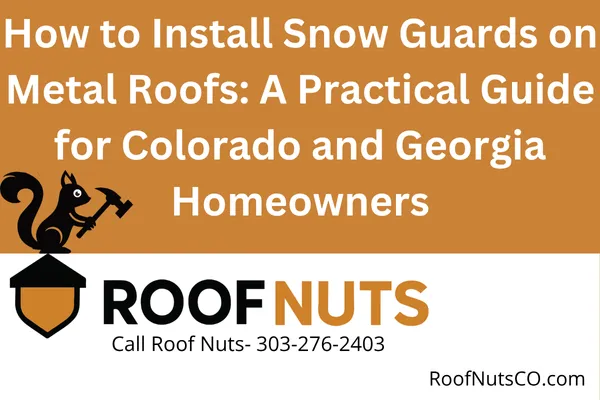
How to Install Snow Guards on Metal Roofs: A Practical Guide for Colorado and Georgia Homeowners
Metal Roofing Snow Guard Installation: What You Need to Know
Snow sliding off metal roofs can pose serious risks to gutters, vehicles, landscaping—and most importantly, people. That’s why installing snow guards is a smart move for homeowners and property managers in Colorado and Georgia. Here’s a simple, clear guide to help you understand the process and the purpose.
What Are Snow Guards?
Snow guards are devices installed on metal roofs to hold snow in place and allow it to melt gradually. Without them, snow and ice can slide off in large sheets, causing damage or injury.
Why Metal Roofs Need Snow Guards
Metal roofs have a slick surface. Once snow starts to melt, gravity can pull it down in dangerous chunks. Snow guards help:
Prevent ice dams at the eaves
Protect gutters, skylights, HVAC units, and parked vehicles
Reduce liability for injuries caused by falling ice or snow
Prolong roof and building life by reducing sudden weight shifts
Best Practices for Installing Snow Guards
1. Choose the Right Type
There are two main categories:
Individual guards: Small units spaced across the roof in a staggered pattern
Snow rail systems: Continuous bars that run horizontally across the roof
Each has its place. Rail systems work best in high-snow areas like Colorado’s mountain towns. Individual guards are often used for aesthetic or budget reasons.
2. Proper Placement
Snow guards should be installed:
6"–12" above the eave edge
In multiple rows if the roof is longer than 20 feet from ridge to eave
Aligned according to manufacturer spacing guidelines
Snow load zones vary by city. Denver and Fort Collins will require more protection than Atlanta or Savannah.
3. Fastening
There are two methods:
Mechanical: Screwed into structural panels (use non-penetrating clamps on standing seam roofs)
Adhesive: For architectural panels where drilling is not recommended
Use manufacturer-approved sealants and follow IBC 2021 attachment specs for snow retention devices.
4. Match the Metal
Snow guards should be made from the same material as the roof (usually aluminum or stainless steel) to avoid galvanic corrosion.
Code Considerations
The International Building Code (IBC 2021) stresses:
Load paths must be accounted for in snow retention systems
Penetrations must not compromise roofing system performance
Installation must not interfere with roof drainage
Always confirm with your local building department in cities like Denver, Colorado Springs, or Atlanta.
Maintenance After Installation
Inspect yearly before and after winter
Look for loosening or corrosion
Check surrounding sealants for cracking or UV damage
FAQs
How many snow guards do I need?
The number depends on your roof pitch, snow load, and roof area. A roofing professional can do a layout calculation based on your local conditions.
Can I install snow guards myself?
You can, but improper installation can cause leaks or ineffective snow control. It’s best to have them professionally installed.
Do snow guards damage metal roofs?
Not if installed correctly. Use clamp-on systems for standing seam roofs to avoid penetrations.
Need help figuring out snow retention for your home or commercial building?
Contact Roof Nuts in Colorado or Georgia
📍 RoofNutsCO.com – 303-276-2403
📍 RoofNutsGA.com – 404-476-6851
Let us help you stay safe this winter—because what slides off your roof matters.
